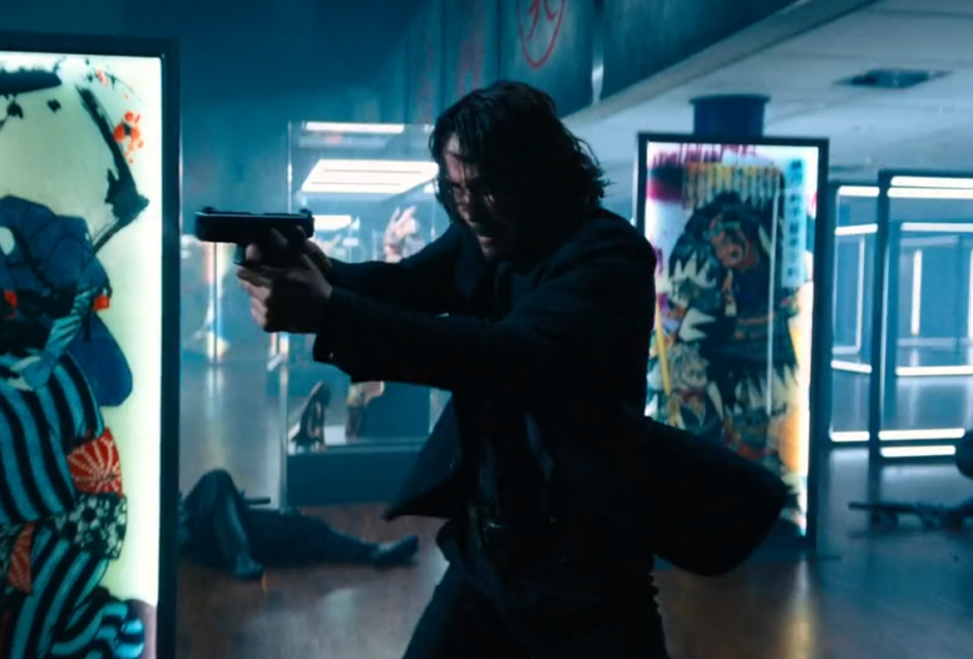The John Wick series of films and franchise as a whole is wildly popular which it achieved by basing its identity primarily off its sheer amount of action sequences and the creativity they find with their violence. It might be easy to describe most action films in a similar way but specifically in the case of John Wick Chapter 4 I find that the action really is the bulk of the movie and likely why you many went to watch it. They use the interest people have built up from the previous films to show as much uninterrupted action as they possibly can in the final entry to the series or at least final outing of John Wick as a character.
Action scenes are usually defined as scenes that “contain a series of shots with high motion activity and fast edits.” This can certainly be relevant with John Wick Chapter 4’s action sequences, but during many scenes throughout the movie movement is kept to a minimum both with the camera and even with the actors. During one scene in particular showing John Wick fighting against two armored enemies the camera almost entirely halts, it fixates on one particular angle and only slightly pans to ensure that all of the action is on screen. Occasionally it may cut to switch the angle but the movement of the camera remains minimal and even the point of view remains consistently from a perspective that is behind or at least far away from John Wick. The violence that the actors are portraying is very much still over the top but the movements remain relatively grounded, I feel that the much slower and strained movements of the actors; specifically Keanu Reeves performance as John Wick, is both to simulate the effect of the constant injuries John Wick has received but also the age of the character, So in this case “instead of negating the weaknesses and wounds that come with old age, [the film will] operationalize, or even weaponize, the frailties of its heroes in a way that sustains the violent rhetoric of the genre.” Overall the violence in this scene is slow paced, John Wick isn’t slaughtering hundreds effortlessly in mere seconds, but is instead displayed as receiving much physical strain from fighting against only two other enemies in a scene that lasts a little under a minute. Another thing that is important to consider with this action sequence is the minimal use of blood. The franchise isn’t afraid to depict intense scenes of violence and brutality complete with blood and bullet holes, but in this scene and even a few others blood splatters are used sparingly. No matter how many times John Wick shoots and stabs at these two the blood splatters are specifically reserved for when he deals the killing blow.
John Wick Chapter 4 made $440 million at the box office with a budget of $100 million. Chapter 4 of course being not only a successor to three previously well received and profitable films but also the finale of its franchise, definitely made it a big deal for the many who enjoyed the previous films. The film received very positive reviews which likely led many of the early viewers to spread the word about the film, as “unlike critical reviews, which are static and occur mostly before the movie is released, [word of mouth] is a dynamic phenomenon that begins before release and spans the entire run.” With so many viewers and such high praise for a film that; as I previously stated, its action scenes make up the bulk of its long run time, it brings to mind just what effect viewing such constant bloodshed may have on the viewer. I feel that John Wick Chapter 4 effects on people would be around the same as any action movie similar in structure to it, Although some movies can definitely get much more visceral, the action can still desensitize people to potentially real world violence, “the audience emanates a delightful feeling while watching the film, regardless of the binding laws and moral code in the real material world.”
John Wick Chapter 4 is a very unique action film in its cinematography, editing, acting, and of course its various action sequences. It follows many common traits of action film but also offers changes from those tropes with slower paced violence, much less over the top camera movements, and a main character whose actions display strain, exhaustion, and frequent physical pain. Yet at the same time this is a film that primarily focuses on its violence and its entire identity can be disregarded as just another over the top action film to add to the already dominant genre.
Bibliography
Sorschag, Robert, and Markus Horhan. “Action Scene Detection from Motion and Events.” 2011 18th IEEE International Conference on Image Processing, September 2011, 3641–44. https://doi.org/10.1109/icip.2011.6116507
Soberon, Lennart. “Too Old for This Sh*t: Aged Action Heroes, Affect, and ‘the Economy of Exertion.’” Journal of Popular Film and Television 49, no. 3 (July 3, 2021): 155–67. https://doi.org/10.1080/01956051.2021.1957336
“John Wick: Chapter 4.” Box Office Mojo. Accessed March 30, 2025. https://www.boxofficemojo.com/release/rl1644725761/
Liu, Yong. “Word of Mouth for Movies: Its Dynamics and Impact on Box Office Revenue.” Journal of Marketing 70, no. 3 (July 2006): 74–89. https://doi.org/10.1509/jmkg.70.3.074
Ma, Tao, Hongwei Liu, and Hongji Yang. “Interactive Narrative Generation of Aesthetics of Violence in Films.” 2020 IEEE 20th International Conference on Software Quality, Reliability and Security Companion (QRS-C), December 2020, 657–62. https://doi.org/10.1109/qrs-c51114.2020.00111


Yunisha
Crispin’s did a great job looking at John Wick: Chapter 4, giving a thorough view of the film’s action scenes. The focus on one specific fight scene, where the camera stays still, highlights the character’s fatigue and pain. I agree with this viewpoint. The slow speed of the action makes it seem more believable, depicting John Wick as someone who faces difficulties, rather than as an invincible hero. This is a nice change because a lot of action films portray their heroes as effortlessly defeating everyone without any problems.
Crispin does a great job of connecting this scene to scholarly research. The idea of using age and physical strain to add more depth to the character is supported by the concept of the “economy of exertion” in action films. Linking research to the analysis makes it stronger and turns it into more than just a personal view. It provides a strong academic basis for the analysis. The picture Crispin includes in the post is spot on. It shows the slow and intense violence of the fight, helping to explain how this scene is different from typical fast-paced action. In general, Crispin’s analysis mixes personal thoughts with academic references, creating a thoughtful and complete look at John Wick: Chapter 4. The post successfully brings together critical thinking and scholarly sources, making it a strong analysis.